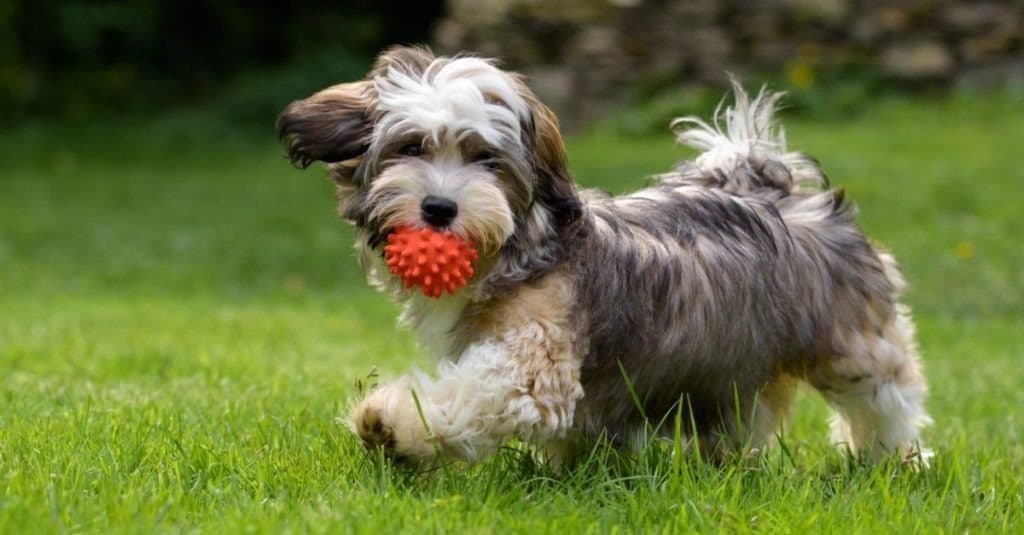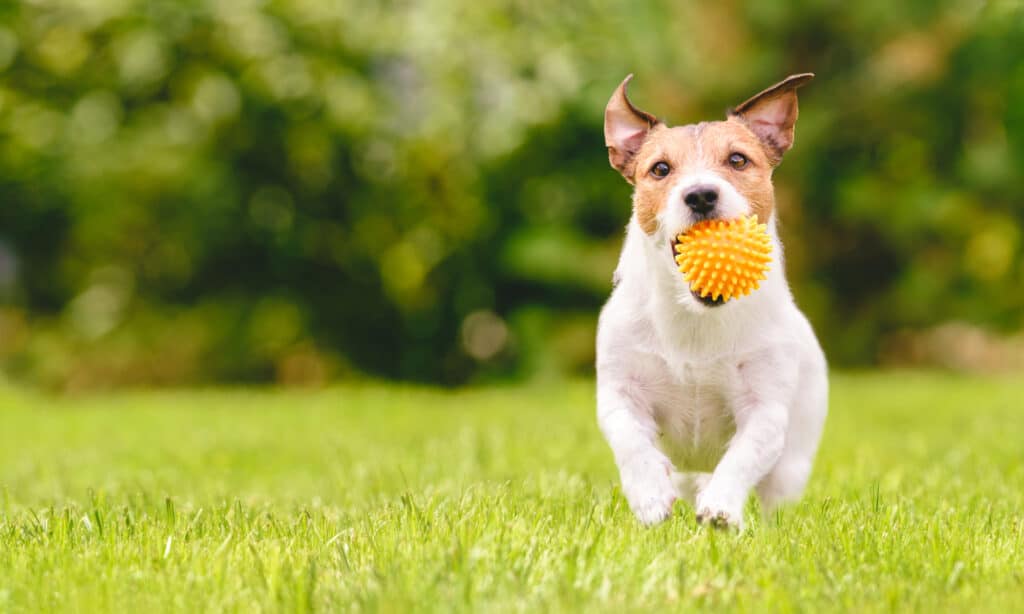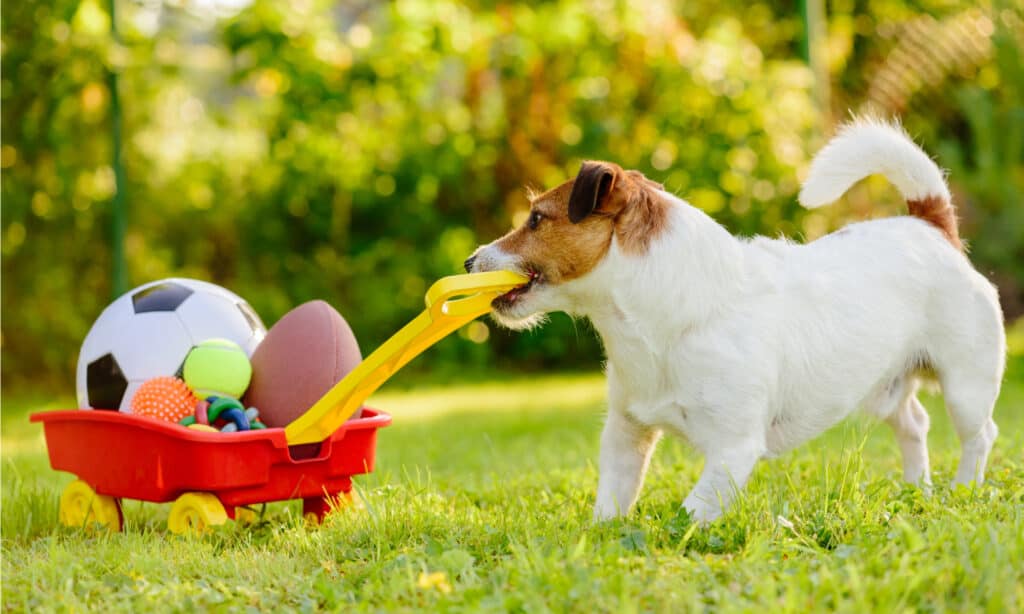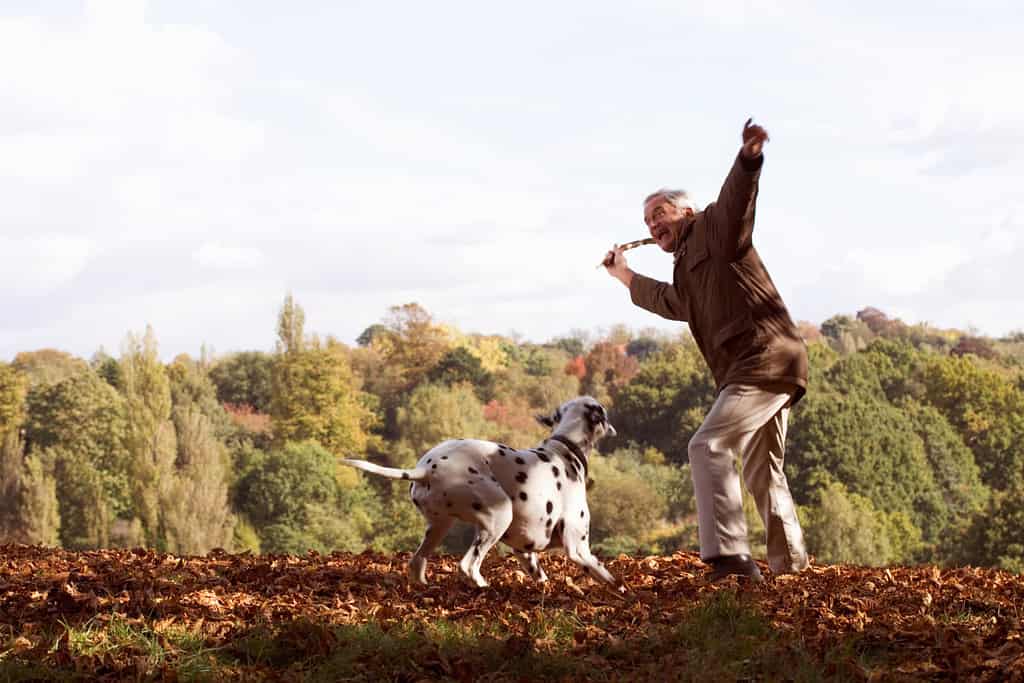Playing fetch is a fun and entertaining way to bond with your pup. From a young age, puppies can learn to pick up a toy and bring it back to their owner. Retrievers, in particular, are known to fetch objects naturally, but you can teach any dog to fetch with committed practice.
While it might take some time for your dog to understand your verbal cues and commands, eventually, you can make playing fetch like second nature to them. Here’s a step-by-step guide to teaching your dog how to fetch.
1. Start Indoors
Because there are fewer distractions indoors than there are outdoors, it’s best to practice with your pup inside. Sensory overload can make it difficult for them to pick up on your commands and cues, or they might be tempted to run after an animal or roll around in the grass. Choose an open room in your home to get started slowly, and you can eventually move outdoors once they’re picking up on the action.

Contrary to the popular adage, you
canteach an old dog new tricks — including fetch!
©Popova Valeriya/Shutterstock.com
2. Introduce the Toy
Dogs must first be aware of what they are fetching before they can fulfill your commands. Before you get started, introduce your pup to the toy you’ll be using for fetch. Typically, this would be a tennis ball or other dog-friendly plush toy that’s easy for them to pick up in their mouth. Make sure the toy is not so small that it’s a choking hazard or too big that it’s hard for them to fit it in their mouth comfortably. This will depend on the size of your dog.
Some puppies prefer certain toys to others, so give your dog some options at first and see which one they gravitate to. For example, a rescue pup with no prior experience with toys might be hesitant to pick up a tennis ball or chew toy; in this case, you can use a velcro toy that lets you pack food into it so they naturally pick it up. Other pups might enjoy a plush toy over a round ball. Let your furry companion decide on their preference — then eliminate the other options so they can hyper-focus on that one toy.

Choose the toy your dog naturally prefers and gravitates toward.
©Valeriya Dzyuba/Shutterstock.com
3. Let Your Pup Examine the Toy
Once your dog made their decision, allow them to sniff the toy, roll it around with their paws, pick it up, and spend some time with it. When they gain awareness of the toy, they’ll feel more comfortable fetching it. During this step, push the toy around a bit so they have to move for it. This will not only pique their interest, but it will also encourage them to retrieve it — even if it’s just from short distances.
You can also hold the toy at arm’s length, kick it around with your feet, and encourage your pup to touch it. Any time they pick it up, praise them with verbal affirmations in a sweet and excited tone of voice so they know you approve of the action. You can even reward them with a small treat so they associate the action with something positive.

The more your pup plays with the toy, the more likely they’ll be to chase after it and retrieve it.
©iStock.com/zabo69005
4. Teach Your Dog How to Hold the Toy
The next step is to teach your pup how to hold the toy in their mouth. While they might have already picked up on this, you can get them more used to holding it by sitting with them and extending the toy out to them. Whenever your pup grabs it with its teeth, praise them or give them a treat, making sure you say “hold” each time they do so.
However, make sure you’re not doing this too soon; wait a few moments after they have it in their mouth before rewarding them. That way, they know not to just grab and drop it. This will help teach them to carry the toy in their mouth. You can increase the duration by waiting longer amounts of time as you continue practicing. Work up to the point where your dog is holding the toy in its mouth for more than a few seconds before moving on to the next step.

Getting your dog used to holding the toy in its mouth is an important step of fetch training.
©iStock.com/Ksenia Raykova
5. Place the Toy on the Ground and Tell Your Pup to ‘Hold’ It
Now that your pup knows the command “hold,” place the toy on the ground in front of them and instruct them to “hold it” You can help by pointing to the toy so they’re aware of it. Hopefully, they’ll know to pick up the toy by this stage. If they’re still having trouble, you can grab it for them and hold it in front of them until they reach for it, praising them and repeating “hold” each time they do this.
Once they do grab the toy from the ground, continue moving it around and increasing its distance each time. Don’t start throwing the toy just yet; take your time at this stage so they really understand how to grab it off the ground and give it back to you.
Additionally, encourage them to hold the toy out to you so you can repeat this process. You can give them your hand and say “out” or “drop it” so they know to return it to you. This is a crucial step in the training, so don’t rush this part.

Allow your dog some time to get used to holding the toy in their mouth.
©Julia Zavalishina/Shutterstock.com
6. Start Throwing the Toy Short Distances
Once your furry friend is picking up, holding, and dropping their toy back to you, you can begin tossing it short distances. Don’t throw it far off the bat, however, as this can confuse them. Start by holding the toy in front of their face, allowing them to sniff and grab for it, then gently toss it a few feet, saying “fetch” or whichever verbal cue you want to use.
Your pup will learn based on the reassurance you provide, so reward them with a treat or praise each time they do as you ask. Give them lots of love and affection, petting them and telling them “good girl” or “good boy” to reinforce their job well done. Keep at this for a while before moving much further.

Keep the toy close at first — you don’t want to confuse or overwhelm your pup!
©Dorottya Mathe/Shutterstock.com
7. Increase the Distance You Throw the Toy
You can begin increasing the distance you throw your dog’s toy as they get used to retrieving it. Slowly but surely toss the toy away from you, experimenting with different directions and ensuring they bring it back to you each time. Continue using the verbal cues of your choice, whether that’s “fetch” or “get it,” and praise them over and over until they understand. Repeat this step as many times as you need. Eventually, fetching will become second nature to them.

Playing fetch with your dog is a great source of exercise and an excellent distraction from chasing small animals.
©alexei_tm/Shutterstock.com
8. Practice Outside
In the beginning, as mentioned earlier, you might want to start training your pup indoors so there aren’t many distractions. However, once they get the hang of it, you can continue this process outside, where there’s more room and freedom for them to run. Get them excited as you practice, praising them in an upbeat tone and cultivating a bonding experience. Gift them their favorite treats and lots of belly rubs.

You can make fetching a fun and friendly competition by involving multiple pups.
©otsphoto/Shutterstock.com
9. Vary the Toys
Once you’re sure your pup has mastered the art of fetching, you can begin introducing different types of toys to the mix. If you were practicing with a tennis ball, now use a plush toy, or vice versa. Remember to continue saying your verbal cue so they associate “fetch” or “get it” with the action.

Dogs tend to prefer a variety of toys, so consider offering them different options.
©alexei_tm/Shutterstock.com
10. Get Everyone Involved
At this stage, you can also get others involved in the process. Include your family members and loved ones so everyone can join the fun! That way, your dog will understand this command regardless of who is speaking it.

Make fetch a family-friendly activity for all to enjoy.
©Juice Flair/Shutterstock.com
Ready to discover the top 10 cutest dog breeds in the entire world?
How about the fastest dogs, the largest dogs and those that are -- quite frankly -- just the kindest dogs on the planet? Each day, AZ Animals sends out lists just like this to our thousands of email subscribers. And the best part? It's FREE. Join today by entering your email below.
Thank you for reading! Have some feedback for us? Contact the AZ Animals editorial team.








